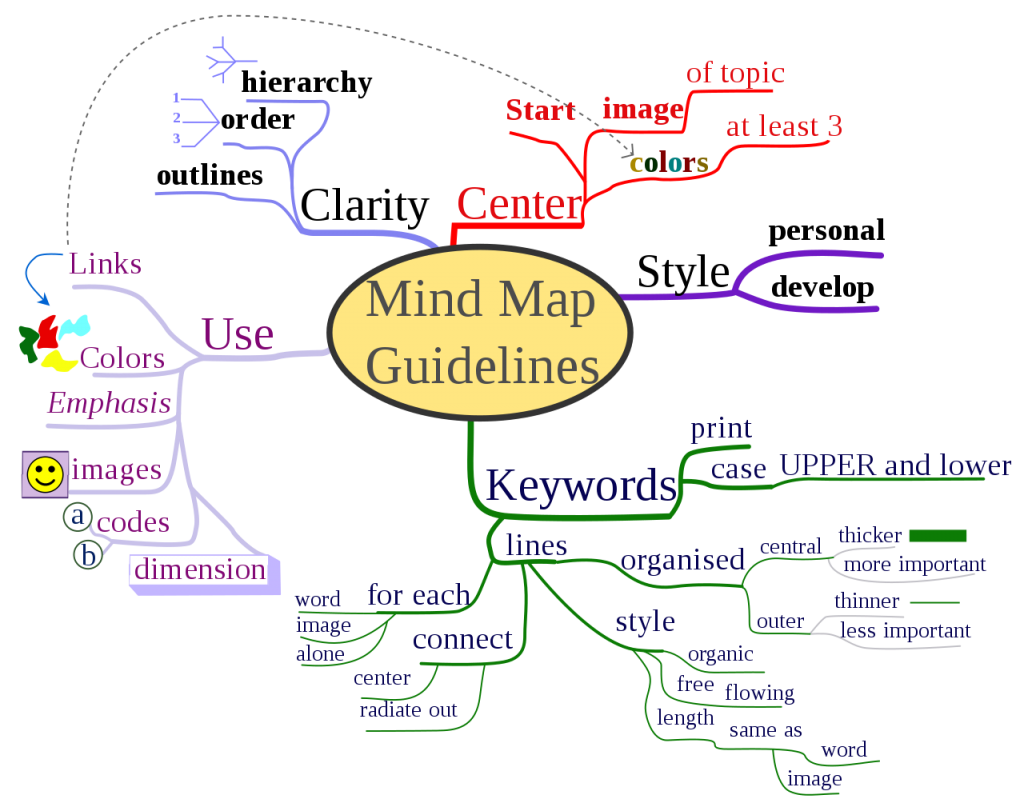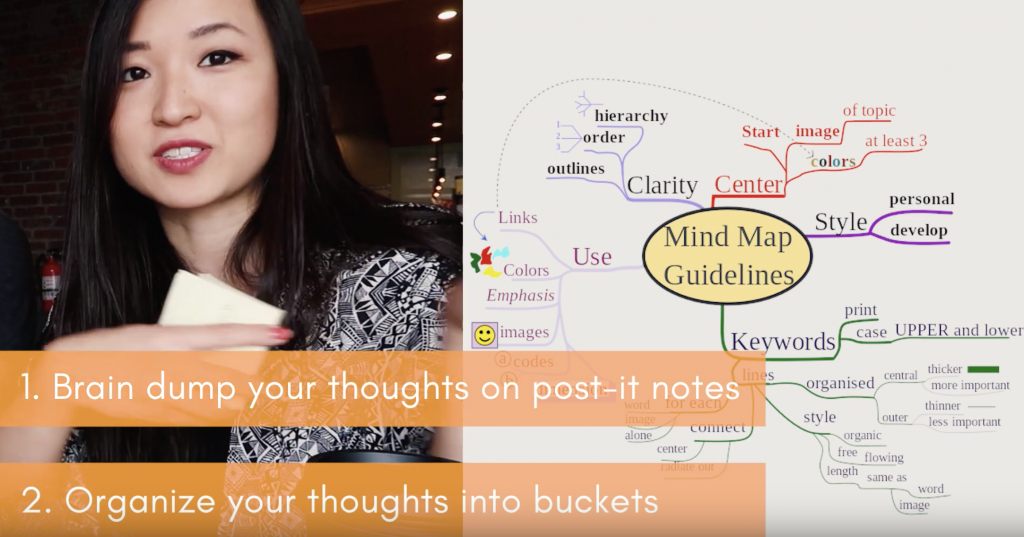If you’ve been following along, you’ll know that I made a YouTube video about mind mapping. Pat Flynn is a huge believer in mind maps and talks about it in his book Will It Fly, and I became intrigued just from reading about this concept. Mind mapping is a great way to think of business ideas, especially if you haven’t tried brainstorming topics yet. In the video, Sean and I used a bunch of post-it notes and slapped them on a desk with ideas for our entrepreneurial pursuits. Then we bucketed them into different categories to see if our ideas could be beneficial.
After making the video, one of my writers Garry Goertzen wrote an awesome post about how to mind map that covers everything about how mind maps came about, their effectiveness, and tips on how to create your own mind map. Enjoy!
How To Mind Map – Mind Mapping for Beginners
What is a Mind Map?
A specific type of diagram, mind maps are ideal for planning, brainstorming, gathering information, and presenting data among many other uses. They can be used in corporate and personal settings, and are often used in schools and businesses. A mind map can include words, colors, and simple images.
Mind maps are highly effective because they have both sides of the brain working together. The brain’s left side controls logic, details, and analytics and is organized and structured. The right side is creative, imaginative, and free-thinking. The term “think outside of the box” essentially means putting the left side of the brain – the logical side- to rest and allowing the right side to be free with creative thoughts and exploration.
It’s in this situation that mind maps become useful. Although the left side of the brain is less active using mind maps, it is not forgotten. Mind maps allow creative thoughts and ideas to be organized using logic and reason, regardless of how unrealistic and imaginative they might be.
A good mind map will encourage the use of the entire brain.
History of The Mind Map
The general concept of mind mapping has been in use for centuries, with this particular form of creative thinking and organization going as far back as 3rd century BC. Porphyry of Tyros, an early philosopher, is thought by many to be one of the first to use mind maps. He used them to organize his ideas, thus making them easier for others to understand.
Ramon Llull is another early adopter of mind maps. A Catalan philosopher and successful author who published one of Catalan literature’s first major works, it’s been noted that he used many mind maps to organize his thinking. In addition, historians have found that Leonardo da Vinci may have used mind mapping as well. Although he used it primarily for note taking, he is often regarded as the historic being that made mind mapping popular.
After Leonardo, various traces of mind maps and mind mapping were found throughout history, but they quickly seemed to fall into irrelevancy, making a comeback sometime between the 50’s and 60’s. Network semantics were developed in the late 50’s as a theory in which to understand various demonstrations of how human beings learn. This new concept was further developed by Dr. Alan Collins and Ross Quillian in the 1960’s, as both men used a similar structure for idea organization: concepts and ideas linked together to show how things relate to one another.
Thanks to the adaptation of mind mapping techniques by these men, mind mapping quickly grew in popularity. It become a go-to method for sharing concepts, learning, and other collaborative efforts.
The late 1960’s saw a tremendous increase in the use of mind mapping after British psychologist, Tony Buzan, adopted the concept. He not only utilized the technique but also developed a set of rules to be used throughout.
Today, mind maps are used everywhere from the office to secondary and post-secondary schools. They are still done on paper, but are most often done using a computer and a text editing software or specially designed mind mapping software.
Why and how are mind maps effective?
After placing an idea or task in the center of the mind map and adding categories and subcategories to it by branches, it’s not uncommon for the creator to sit and wonder if the time they spent creating the map could have been better used elsewhere. In short, the answer is yes; mind maps are very much worth the time that goes into creating them. Creating mind maps is beneficial for visual representations of ideas and organizing important information and points. When used correctly, mind maps can boost the efficiency of problem solving.
Here are a few ways that mind maps prove to be effective solutions. They:
- Increase our likelihood of seeing the bigger picture
- Help us to focus on key issues
- Clarify thinking
- Aid in recalling specific information
- Allow you to manage and organize ideas
- Create simple visuals
- Work both the left and right brain
To further explain some of their benefits, here is an in-depth breakdown of two of the points mentioned above.
Idea Management and Organization
Mind maps increase productivity by allowing ideas to flow freely without getting off subject too much. When brainstorming without a mind map, the mind is likely to wander and become distracted, but mind maps keep the mind grounded and focused on one subject.
When using a mind mapping software, every single thought or idea you have needs to connect to the central idea. As a rule of thumb, if an idea can’t somewhere connect to a category or sub-category, it shouldn’t be placed on the map. This guideline will help keep you on track and focused on your primary idea.
Simple Visuals
Mind maps have a distinct way of presenting ideas through the use of simple, easy-to-understand visuals. This helps you to reach decisions quickly and efficiently. When you read information, your brain processes it, comes up with its own images, and ultimately connects the dots. When taking in information through the use of an image-based mind map, productivity is increased because the brain already has visuals and does not have to come up with its own.
Text-based information often comes across as flat and boring, but a visual representation is both unique and interesting. Much like the branches of a tree, mind maps showcase clear, distinct patterns and connections. Information presented in the form of a mind map turns into knowledge and helps in the decision making process.

What Types of Mind Maps Are There?
Library Mind Maps
Library mind maps, which are also known as reference maps, are used to organize information using visuals, allowing various pieces of information to be showcased without a loss of quality. This kind of mind map is one of the most commonly used; you have probably seen it before. It starts with a collection of broken, half-formed ideas that are then linked together in a tree-like structure.
Library mind maps can be used to:
- Explore a complex scientific topic and its related ideas. For example, a scientific research team may use this method to explore a specific problem, such as global warming, and brainstorm various solutions, connecting them by relevance and common ideas.
- Organize information surrounding s topic or idea, showcasing it in a way that is easy to follow during group discussions.
Presentation Mind Maps
Presentation mind maps are used to present the progression of ideas. For example, telling a story or presenting a call to action. This type of mind map visually notes ideas and their information by a specific order. Unlike the library mind map, the presentation mind map is designed to follow the discussion and give its flow visualization, rather than controlling the session through the collection of ideas.
This type of mind map is used to:
- Present the specifics of consumer behavior when using a product and/or the steps that the consumer took to achieve the goal. An example is buying a product or subscribing to a newsletter or service.
- Training sessions, when the trainee needs to follow the specific directions of information.
- Discuss an argument or situation and the steps based on it
Planning Mind Maps
When planning for a specific project or choosing from different actions during the process of the project, the planning mind map can be used to visually present various plans of action and strategies. With this type of map, the central idea is reflected by the subcategories and surrounding ideas, all of which are designed to achieve the central goal. Each sub-topic aims to represent a path that moves toward achieving the goal. For example, the central idea can be increasing market share with a specific percentage, with the relating topic focusing on the ways in which the goal will be achieved.
These types of mind maps can be used to:
- Plan projects and build project strategies that can be achieved through specific steps
- Solve problems through setting the search for a solution as the central idea and discussing the possible methods for solving the problem during the brainstorming phase.

Tips To Create Your Own Mind Map
- Begin in the center of a blank page that has been turned sideways. This is done because starting in the center of the paper gives the brain the freedom to expand in all directions, expressing itself naturally.
- A picture or image should be used as the central idea in most cases. Why? Images, as has been said for years, are worth a 1000 words. Images have the power to convey much more information than a word, sentence, poem, or essay – they tend to take up less space, too. The brain processes them instantly, encouraging it to recall information.In addition, images are a universal language that the world as a whole understands. From a young age, we’re taught to decode and understand images. According to Margulie, children learn to visualize picture-concept links before they are able to learn a language. For this reason, mind maps are excellent tools for maximizing the impact of imagery. A central image is not only more interesting, but also keeps you focused and helps you concentrate on the task at hand.
- Make use of colors throughout your mind map. Colors are visually stimulating to brain, as are images. Color adds extra vibrancy and life to any mind map. Not to mention that color is visually appealing to the eyes and draws attention to it.
- Your main branches should connect to the central image. From there, the second and third-level branches should be connected to the first and second levels, and so on. Because the brain works by association, it has a natural tendency to link two or more things together. When these branches are connected, they are easier to remember.
- Your branches should be made curved instead of straight. It’s a fact that straight lines are monotonous and unappealing to the eye, whereas curved lines offer more interest. This in itself will help you make use of your branches, as you’ll be more keen to focus on them.
- Every branch should have a key idea. One of the most important mind mapping principles is that one word should be used per branch. Sticking to one word per branch sparks a greater number of associations than those with multiple words. For example, if your branch has the words “birthday party”, you are restricted to aspects connecting to birthday parties. However, using the word ‘birthday’, you can radiate out and explore the keyword -party- but also a wide variety of other keywords such as “presents” and “food”.
Conclusion
I hope you enjoyed this very in-depth post on how to think of business ideas through mind mapping. Please comment below if you’ve ever done some mind mapping for your business!




